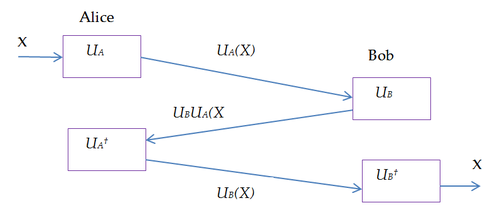The three-stage quantum cryptography protocol, also known as Kak's three-stage protocol is a method of data encryption that uses random polarization rotations by both Alice and Bob, the two authenticated parties, that was proposed by Subhash Kak. In principle, this method can be used for continuous, unbreakable encryption of data if single photons are used. It is different from methods of QKD (quantum key distribution) for it can be used for direct encryption of data, although it could also be used for exchanging keys.

The basic idea behind this method is that of sending secrets (or valuables) through an unreliable courier by having both Alice and Bob place their locks on the box containing the secret, which is also called double-lock cryptography. Alice locks the box with the secret in it and it is transported to Bob, who sends it back after affixing his own lock. Alice now removes her lock (after checking that it has not been tampered with) and sends it back to Bob who, similarly unlocks his lock and obtains the secret. In the braided form, only one-pass suffices but here Alice and Bob share an initial key.
This protocol has been proposed as a method for secure communication that is entirely quantum unlike quantum key distribution in which the cryptographic transformation uses classical algorithms
The basic polarization rotation scheme has been implemented in hardware by Pramode Verma in the quantum optics laboratory of the University of Oklahoma. In this method more than one photon can be used in the exchange between Alice and Bob and, therefore, it opens up the possibility of multi-photon quantum cryptography. This works so long as the number of photons siphoned off by the eavesdropper is not sufficient to determine the polarization angles. A version that can deal with the man-in-the-middle attack has also been advanced.
Parakh analyzed the three-stage protocol under rotational quantum errors and proposed a modification that would correct these errors. One interesting feature of the modified protocol is that it is invariant to the value of rotational error and can therefore correct for arbitrary rotations.
See also
References
- Cardinal, David (March 11, 2019). "Quantum Cryptography Demystified: How It Works in Plain Language". Extreme Tech.
- Kak, Subhash (2006). "A Three-Stage Quantum Cryptography Protocol". Foundations of Physics Letters. 19 (3): 293–296. arXiv:quant-ph/0503027. Bibcode:2006FoPhL..19..293K. doi:10.1007/s10702-006-0520-9. S2CID 7245233.
- Chen, Yuhua; Verma, Pramode K.; Kak, Subhash (2009). "Embedded security framework for integrated classical and quantum cryptography services in optical burst switching networks". Security and Communication Networks: n/a. doi:10.1002/sec.98.
- James Harold Thomas (2007). "Variations on Kak's Three Stage Quantum Cryptography Protocol". arXiv:0706.2888.
{{cite journal}}: Cite journal requires|journal=(help) - Darunkar, Bhagyashri; Verma, Pramode (2014). "The braided single-stage protocol for quantum secure communication". In Donkor, Eric; Pirich, Andrew R; Brandt, Howard E; Frey, Michael R; Lomonaco, Samuel J; Myers, John M (eds.). Quantum Information and Computation XII. Vol. 9123. p. 912308. doi:10.1117/12.2050164. S2CID 62145124.
- Thapliyal, Kishore; Pathak, Anirban (2018). "Kak's three-stage protocol of secure quantum communication revisited: Hitherto unknown strengths and weaknesses of the protocol". Quantum Information Processing. 17 (9): 229. arXiv:1803.02157. Bibcode:2018QuIP...17..229T. doi:10.1007/s11128-018-2001-z. S2CID 52009384.
- A multi-photon approach to quantum cryptography http://www.kurzweilai.net/a-multi-photon-approach-to-quantum-cryptography
- Quantum optics lab. http://www.ou.edu/coe/tcom/research/quantum-optics1.html
- Verma, P.K.; et al. (2019). Multi-photon Quantum Secure Communication. Signals and Communication Technology. Springer. doi:10.1007/978-981-10-8618-2. ISBN 978-981-10-8617-5. S2CID 126012309.
- Mandal, S.; MacDonald, G.; El Rifai, Mayssaa; Punekar, N.; Zamani, F.; Yuhua Chen; Kak, S.; Verma, P. K.; Huck, R. C.; Sluss, J. (2013). "Multi-photon implementation of three-stage quantum cryptography protocol". The International Conference on Information Networking 2013 (ICOIN). pp. 6–11. doi:10.1109/ICOIN.2013.6496343. ISBN 978-1-4673-5742-5. S2CID 1055005.
- Clifford Chan, Kam Wai; El Rifai, Mayssaa; Verma, Pramode; Kak, Subhash; Chen, Yuhua (2015). "Security Analysis of the Multi-Photon Three-Stage Quantum Key Distribution". International Journal on Cryptography and Information Security. 5 (3/4): 01–13. arXiv:1503.05793. doi:10.5121/ijcis.2015.5401. S2CID 3220239.
- Parakh, Abhishek; Van Brandwijk, Joel (2016). "Correcting rotational errors in three stage QKD". 2016 23rd International Conference on Telecommunications (ICT). pp. 1–5. doi:10.1109/ICT.2016.7500409. ISBN 978-1-5090-1990-8. S2CID 11693845.